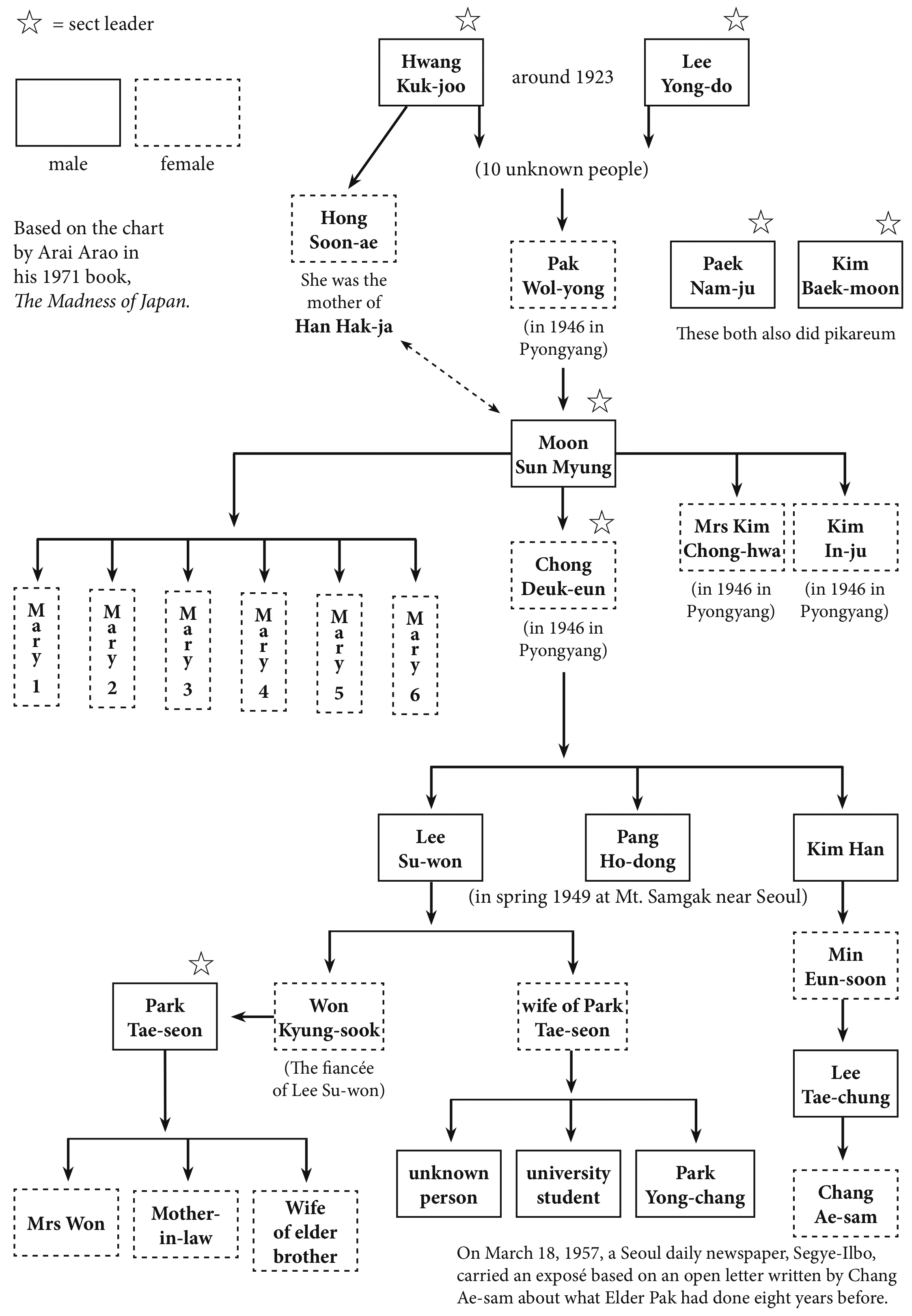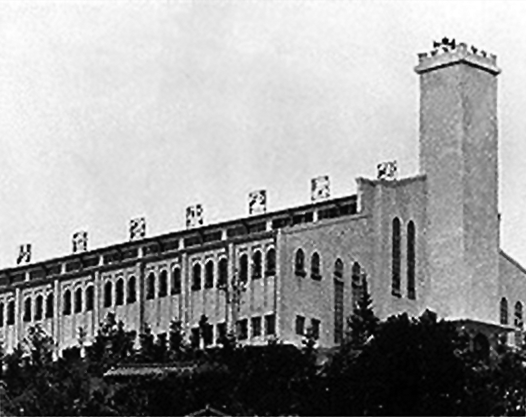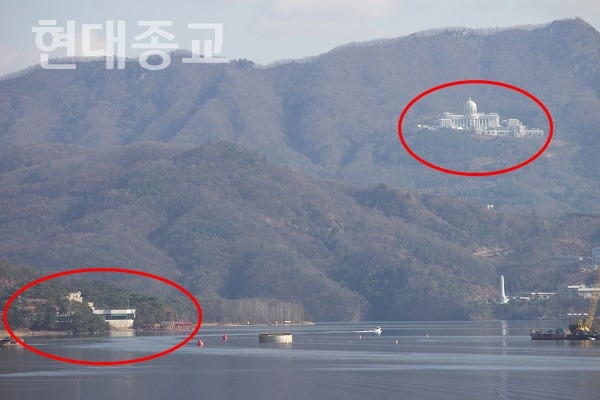Updated April 27, 2021
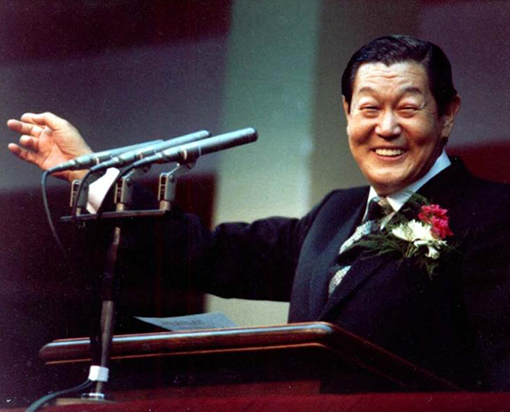
▲ Elder Park Tae-seon preaching in 1956
Is anything in this story similar to another Korean messiah, Sun Myung Moon?
This chart of the lineage of pikareum is based on one by Arai Arao on page 102 of his book, The Madness of Japan – The Federation [for Victory over Communism] and the Unification Church (1971)
日本の狂気―勝共連合と原理運動 (1971年) 荒井 荒雄
Information from the 1993 PhD thesis of Choe Joong-Hyun has been added. Sun Myung Moon called Pak Wol-yong “the wife of Jehovah.” He referred to her many times in his Malssum speeches. Choe Joong-Hyun: “Sources give us four different given names of this old woman: Unnae (Malssum 33:134). Ullyong (Ok Se-hyun 1984:320-321), Ullo (Chong Deuk-eun 1958:5), and Wolyong (T’ak Myeong-hwan 1979:56). But here we choose to use “Wolyong” which sounds more natural and familiar as a female Korean name than the other three.”
Chart of Pikareum Relationships 피가름 복귀를 血分け 血代交換
Links to further information on some of the people in the chart above:
Hwang Kuk-joo Lee Yong-do Pak Wol-yong Kim Chong-hwa
Sun Myung Moon Chong Deuk-eun Pang Ho-dong
Lee Yong-do was excommunicated in 1932. At the same time Hwang Kuk-joo was branded a heretic. Sun Myung Moon was excommunicated in 1948 when he was jailed in Heungnam for bigamy. He had been accused of adultery in North Korea from 1946 until the time he was jailed. Paek Nam-ju got in trouble for sex and later gave up any messianic pretensions.
In March 1956 Park Tae-seon was dismissed as an Elder. The General Assembly of the Presbyterian Church in 1956 classified his movement as a cult.
Park was born in a poor peasant family in 1915. After finishing his elementary education, he went to Japan and graduated from a vocational school there. Later, in Korea, he set up his Evangelism Center. At the peak of his ‘ministry’ Elder Park had over a million followers. There were whole communities of followers with factories making clothing, etc. Early on Park was ahead of Moon in the race between the different Korean messiahs. Park’s religion was also known as ‘The Olive Tree Movement’. Now there are not so many of his churches remaining in Korea. There were never many followers outside Korea. Today the official name is ‘Chunbukyo’ ( 천부교 ). Cheon (chun) means Heaven, Bu means Father, and Kyo means Church, so it is The Church of Heavenly Father.
In 1955 Park was involved in a big revival meeting, which proved to be a turning point in his career.
Dr. Kim In Soo, PhD, History of Christianity in Korea (2011) ISBN 978-89-6562-134-8: “Crowds of people came from all parts of the country and there were many with different kinds of diseases seeking healing. Dr. Swanson led Bible exposition sessions in the mornings and evenings, and Park clapped and sang praise songs at dawns and in the afternoons to lead in healing and spiritual ministry. During the remaining sessions, Park collected gold rings, watches, cash and other items from the people by saying that he will build a prayer house for national salvation. Rev. Kim Seon-hwan testifies that Park Tae-seon embezzled all the money collected during the meetings. … The most crucial of the unbiblical doctrines Park taught was the so-called “blood separation” doctrine. Claiming that he “received the precious blood of Jesus, the blood became his, and he was distributing the blood to others,” he taught: “Archangel Michael, fallen as the serpent, committed adultery with Eve and because of that serpent’s blood, and all Eve’s children including Cain carried the original sin. Therefore one can sanctify one’s blood by having intercourse with Park because his body is blessed and sanctified. And the one with separated blood can sanctify others by having intercourse with them. This doctrine of orgies was used to forge mental and spiritual unity among his followers.” Moreover, he called himself “the righteous one of the east and the Olive Tree of the East” mentioned in Isaiah 41. He claimed that he was sent by God from the North (from his hometown in Youngbyon, North Pyengan Province) to save Korea.”
In March 1956 Park was dismissed as an Elder. The General Assembly of the Presbyterian Church in 1956 classified his movement as a cult.
“ ‘the only way to enter the Heaven, believing in the God is no other than for the male and the female to be united into the one body.’ This prophecy itself contradicts the social ethics … let the married couples divorce and conducted the special services of putting hands on the faithful women. He has fulfilled what was foretold. … that the women should receive the grace of the blood exchange ceremony with the righteous man who gives the hands of the help for the salvation. … The Elder, Park Tae-seon had made the thunderbolt-like declaration in the early 1980s, that he is the only God throughout the entire realm of the Heaven, who created the whole universe and the mankind. In addition, he had precisely taught the reasons why the human being was created and why the God of omniscience and omnipotence had come down to this earth for himself incarnated and endured the prison twice and the prospect how the human will become in the future.”
from: www.paikmagongja.org/english/parkteaeseon/park-001.htm
Kirsti L. Nevalainen’s book is very helpful in shedding more light on both Chong Deuk-eun and Elder Park Tae-seon.
Change of Blood Lineage through Ritual Sex in the Unification Church
ISBN 978-1439261538 See pages 86-88
“Rev. Moon’s immediate disciple Ms. Chong Deuk-eun with whom Rev. Moon had a yongch’e ceremony in June 1946 in Pyongyang got a revelation from God and left for South Korea at the beginning of 1947. She was told by God that she must be disconnected from Sun Myung Moon. She occasionally attended Kim Baek-moon’s meetings in Seoul. Stationed at Mt. Samgak, north of Seoul, she successfully convinced quite a few people of her religious mission. Among those who converted to her was Park Tae-seon who was then a deacon at Namdaemun Presbyterian church in Seoul. Deacon Park and his wife were especially faithful to her. In February 1949 she was invited to stay in Deacon Park’s house in Susaek near Seoul and stayed there for about a month. At this place a few young men and women were having a yongch’e or pikareum ceremonies with her. Later Park Tae-seon founded his own messianic group called the Olive Tree Movement. Park Tae-seon considered himself as the Messiah. He claimed that he “has been granted the precious blood of Jesus, which has been wholly permeated in his body which has to be distributed to others.” He practiced thus a blood exchange ritual. He identified his mission with that of Christ by insisting that he was the only one who could distribute the precious blood further. Park Tae-seon’s group had installed separate rooms in the basement of the churches in which men and women had sexual intercourse. These rites drew a large number of people to the movement.”
Dr. Kim In Soo:
“Some time later, Park created self-contained villages at Sosa, Deokso and other places in Gyeonggi Province as a means to building the so-called 1000-year city. He lured many innocent Christians by preaching that 144,000 people will become a holy nation and go up to heaven according to Revelation. Those who believed him liquidated their possessions and cut off their family relations to live in the villages, only to be exploited in harsh labor for producing factory products. These products were then put on compulsory sale at the Evangelism Center for achieving commercial gains. The sect went through a series of internal conflicts and disputes. Park eventually created Cheonbugyo (Religion of Heavenly Father) and presented himself as a God. But his death brought about natural dismissal of the sect and so we see another example of cults in their typical cycle.
Park Tae-seon and his Evangelism Center movement were just like any cultic organization we can see in unstable society after a war. … Another important factor is that existing Christian leaders were unable to fully satisfy the spiritual cravings of Christians at the most crucial time.”
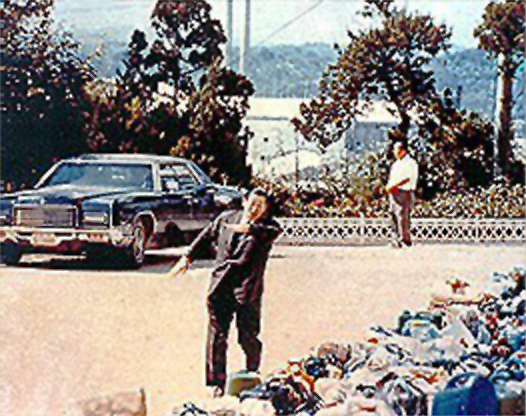
▲ Elder Park Tae-seon with a Cadillac
Following in the footsteps of Park, Moon claimed to be God:
Rev. Yong Jin-Hun heads the UC Department for Education and Witnessing in Korea, and travels the world teaching UC members.
Here is the content of a slide from one of Rev. Yong’s lectures:
“1. 1014 True Parents Cosmic Level Blessing (October 14, 2009).
2. Korea is God’s fatherland and hometown.
3. Jung-Joo is the hometown where God was born.
4. Jung-Joo is the hometown of the first, second and third Israel.
5. Korean is the mother language of God.”
Jung-Joo (or Jeongju) just so happens to be where Moon was born…
In 1948 Moon was excommunicated from the Presbyterian Church.
ref: Jane Day Mook article published in ‘A.D.’ New Growth on Burnt-Over Ground
– May 1974 page 34
Other sources state that Moon was excommunicated at around the time he was arrested and sent to Heungnam prison for adultery and bigamy with Mrs Kim Chong-hwa of Pyongyang. She was also jailed, but released after one year.
Moon and Park both had yongch’e or pikareum sex rituals with Chong Deuk-eun.
(She is also known as Chong Tuk-un.) Rev. Yong Jin-Hun lists her as one of Moon’s leading disciples in Pyongyang in 1946.
Felix Moos: Leadership and Organization in the Olive Tree Movement.
Transactions XLIII:11-27.
“In September 1958, police reported that the number of residents in Elder Park’s Olive Tree Movement believers’ town was 7,467. Outside of the town, there were tens of thousands of members, economically supporting (and being supported by) the town through nationwide sales of goods that were produced in the town.”
[At the same time Moon had about 200 followers in Seoul, and a few in Busan and Taegu, and maybe one other place.]
“Heretical or not, [Elder Park’s Olive Tree] movement by 1964 had from 1,800,000 to 2,000,000 followers in some 303 congregations (Chondo Kwan), against some 97,306 Presbyterians after more than half a century of intense missionary efforts. This perhaps suggests that Park Tae-seon himself is, in his own way, a more reliable interpreter in Korea of the Protestant “ethic” than the Western Presbyterian missionaries have been.”
Professor Felix Moos (Professor Emeritus, Socio-Cultural Anthropology, (Ph.D., Washington 1963) Research Areas: Applied anthropology and ethnology, culture change and development, comparative value systems, ethnic conflict; East and Southeast Asia, Pacific.)
Kim Young-whi, one of the first three couples in 1960, said the pikareum messiah Park Tae-seon did “Wonderful Works” but failed to be a “John the Baptist” and witness to Moon and follow him.
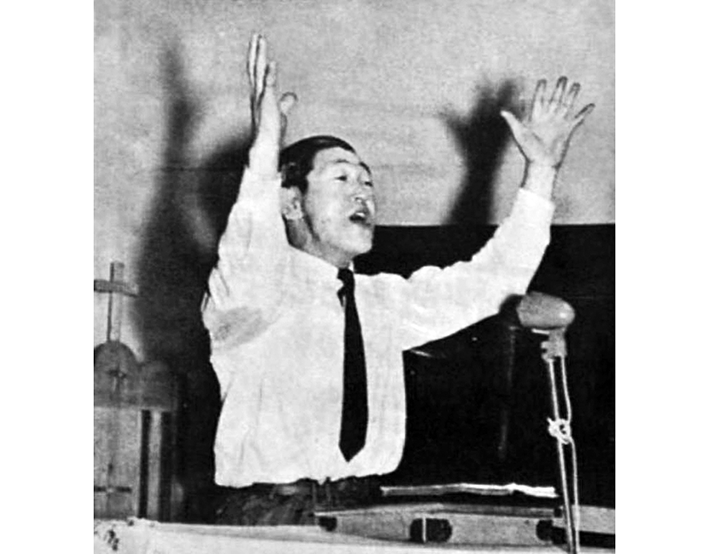
▲ Park Tae-seon had special rooms in his churches where his followers could do the pikareum sex rituals.
Kim Young-whi – January 29, 1984
“There have been many religious leaders, especially in Korea, who did wonderful works. One such was Park Tae-seon, who had great spiritual power…Mr. Park attracted tens of thousands to his revival meetings [and his Olive Tree Movement] and they became his followers… He was in the position of John the Baptist to Father, but he didn’t follow; that’s why his group is almost nothing now.”
http://www.tparents.org/Library/Unification/Talks/Kim/Kim-840129.htm
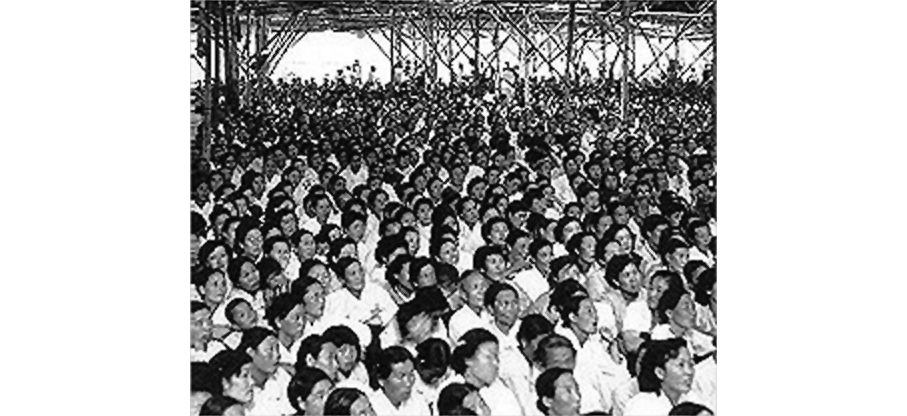
▲ Park Tae-seon had many, many more Korean followers than Sun Myung Moon ever had!
“Heretical or not, the movement by 1964 had from 1,800,000 to 2,000,000 followers in some 303 congregations (Chondo Kwan), against some 97,306 Presbyterians after more than half a century of intense missionary efforts.”
Professor Felix Moos on Park’s Olive Tree Movement, in Transactions of the Royal Asiatic Society (Korea branch) No. 43 (1967) (LINK to PDF document)
Kim Ig-jin, History and Theology of Korean Pentecostalism (page 50):
“Today [2003], there are about 92 Christian sectarian groups in Korea. The total of followers amounts to 180,000. Almost 35 persons fancy themselves to be the re-incarnated Jesus or Jesus at His second coming and 12 claim to be god. …
The main mystical heretics in Korea have their origin in the 1930s. Under Japanese oppression and ecclesiastical lukewarmness, there not only arose Lee Yong-Do’s [or Yi] spiritual revival meetings, but also moral perfectionist (Mr. Hwang Guk-Ju) and counterfeit prophecies (Mrs. Yu Myeong-Hwa, Mr. Han Jun-Myeong, and Mr. Paek Nam-Ju). Especially, Hwang Guk-Ju and Paek Nam-Ju fell into religious adultery, which implies the typical analogy between religious trance and sexual ecstasy.
Such activities were suppressed until the end of the Korean War (1953), but then, they broke out. The Unification Church of Sun-Myung Moon (1920-2012), which was organized in 1954, and the Revival Society of Jesus Evangelization of Korea by Park Tae-seon (1917-1990), which was organized in 1955, are the best examples.”
http://dspace.library.uu.nl/bitstream/handle/1874/605/full.pdf?sequence=2
Hak Ja Han’s mother, Soon-ae Hong, followed Hwang Guk-Ju
Two of these Korean messiahs also practised pikareum, and a third reportedly also did:
Chong Deuk-eun 丁得恩 / 鄭得恩 정득은
Moon met her in Pyongyang in 1946, and had a pikareum ceremony with her. (They may have met in Seoul the previous year.) She and Moon worked together until February 1947 when Chong had a revelation that she should separate from him; she then she moved to near Seoul. Moon took about 17 ideas for his Divine Principle from her theology – which was dictated to a follower in 1947. Her book, The Principle of Life, was based on those notes. It was published in 1958, just after her death.
Kim Baek-moon 金百文 김백문
He developed the Parallels of History, taking ideas from Paek Nam-ju. Moon studied with Kim Baek-moon for seven months from November 1945 to June 1946.
Paek Nam-ju 白南性 백남주
According to some sources, Moon visited Baek Nam-ju in Wonsan in the mid 1940s. For example, see Yamamoto, J. Isamu, 1977 The Puppet Master, page 20.
“In 1954 Moon’s wife of 10 years left him because he claims, “she could not comprehend my mission.”5 Later, on July 4, 1955, in Seoul the police imprisoned Moon and his chief members for three months. His indictment was initially draft dodging but later changed to “communal sex.” Most of his followers were men who had left their wives and were part of the new Unification community. Students and professors were expelled from their universities because of engaging in what were called “the scandalous rites of the Unification Church.”6 The charges were dropped, however, and Moon claims to have been persecuted because of the success of his church. His critics say that he was released because of his health which seemed to have been in poor condition at the time.
[Moon admitted being guilty of draft dodging and was he sentenced to two years in jail. There are reports that money was paid. He was suddenly released late at night. LINK]
What were the “rites” which caused so much controversy concerning the early days of the movement? Moon’s critics say that he gleaned ideas from Nam-choo Paik [Nam-joo Baek] whose Theological Mountain at Wonsan he had visited prior to 1945. One of the more important ideas was “pikareum” or blood separation, a secret initiation rite. It is said that the female members of the Unification Church had to have intercourse with Moon in order to be purified. Later, intercourse between husbands and wives would purify the male members. Thereafter their offspring would be pure.
The Unification Church in the United States now declares that purification is conferred through Moon symbolically at the wedding ceremony. They fervently deny any promiscuous activities on the part of Moon or any other member of the church. There seems to be no reason to suspect Moon of engaging in the rite since his latest marriage. The early days of the movement, however, leave considerable room to doubt the mere symbolism of the rite.”
Sources:
Photos of Elder Park’s religion: http://www.chunbukyo.or.kr/.
Transactions of the Royal Asiatic Society No. 43 (1967)
has a series of articles on Korean religions
PDF file of the magazine is available here:
http://anthony.sogang.ac.kr/transactions/VOL43/KORS0749D_VOL43.pdf
Spencer J. Palmer: The New Religions of Korea: Introduction.
Transactions XLIII:1-10.
Lee Kang-o: Chungsan’gyo: Its History, Doctrines and Ritual Practices.
Translated by Richard Rutt.
Transactions XLIII:28-66.
Choi Jai-sok: A Socio-religious Study of Sindonae.
Transactions XLIII:67-91.
Benjamin Weems: Ch’ŏndogyo Enters Its Second Century.
Transactions XLIII: 92-100.
Choi Syn-duk: Korea’s Tong-il Movement (Unification Church).
Transactions XLIII:101-113.
Newsweek Article on “Many Moons” about the many Korean messiahs in the 1970s
In the 1950s and 60s Sun Myung Moon was jealous of Elder Park’s much greater success as a messiah. A Unification Church member created this fake message from the Spirit World about Elder Park who failed to follow Moon:
“When Elder Park was on earth, he was venerated so highly that his authority seemed to rival that of a god. Next, I would like to describe this person’s appearance and life in the spiritual world.
I found Elder Park living in a community of regular Christians. The standard of these Christians, though, was not that of faithful people who had lived in attendance of the Lord. Instead, their standard was that of people who had put only a little effort into their faith. So, for example, when they sang hymns or prayed, they didn’t know the words very well. They were novice believers. Elder Park was among them. I have never conversed with this person. The reason I have not been in a hurry to speak with him is that it is obvious that he is purposely hiding himself in an area that is not appropriate to his position. From what I’ve seen, I can tell that his faith was based on an arrogant heart, and that he became intoxicated in his mission. In this world, he is living in a place that is considerably distant from God. He still does not understand his position. He lives among novice believers and still holds on to his past domain. I will let some more time pass before meeting him.”
Dan Fefferman:
“There were charges in North Korea that Father’s [Sun Myung Moon’s] group practiced sexual orgies. These are denied by the UC.”
http://www.tparents.org/library/unification/Talks/Feffermn/Fefferman-Pekerun.htm
Lee Man-hee 이만희 (1931- ) founded the Shincheonji 新天地 sect in Gwacheon, Gyeonggi Province, Korea. Shincheonji is an abbreviation of ‘New Heaven and New Earth’ which signifies the new tabernacle and new saints: “But in keeping with his promise we are looking forward to a new heaven and a new earth, the home of righteousness” (2 Pt 3:13).
Lee Man-hee was a follower of Park Tae-seon for ten years from 1957-1967. Elder Park founded the Olive Tree Movement (한국예수교전도관부흥협회, or 전도관).
For further details, please see:
Guwonpa, WMSCOG, and Shincheonji: Three Dynamic Grassroots Groups in Contemporary Korean Christian New Religious Movement History.
by David W. Kim 1, and Won-il Bang 2
1. Department of Political and Social Change, Coral Bell School of Asia Pacific Affairs, Australian National University, Canberra ACT 2601, Australia
2. Department of Religious Studies, Seoul National University, Seoul 08826, Korea
Published: 19 March 2019 https://www.mdpi.com/2077-1444/10/3/212
This article also has information about Sun Myung Moon:
“Moon Sun Myung (문선명) under the impact of Baek Nam-Ju (백남주), Lee Yong-do (이용도), and Kim Baik-mun (김백문) promoted a similar perspective that he himself was the saviour or messiah of physical salvation. He eventually became the founder of the Holy Spirit Association for the Unification of World Christianity (세계기독교통일신령협회, Moonism) in 1954. The canon of the Unification Church is divided into three books of the Old Testament, the New Testament, and Seongya (Holy Promise) which indicates the Divine Principle (원리강론, 原理講論).”
▲ 신천지 연수원 (좌측 하단) 과 천전궁 (우측 상단) 이 한눈에 들어온다. 신천지는 저 위 천정궁을 바라보며 통일교 따라잡기에 열심이다.
▲ Lee Man-hee’s Shincheonji Training Center / Peace Palace (lower left) and the Moon’s $1billion Palace at Cheongpyeong (upper right).
▼ A closer view of Lee’s Peace Palace.
LINK: Lee Man-hee Press Conference at his Peace Palace, March 2, 2020
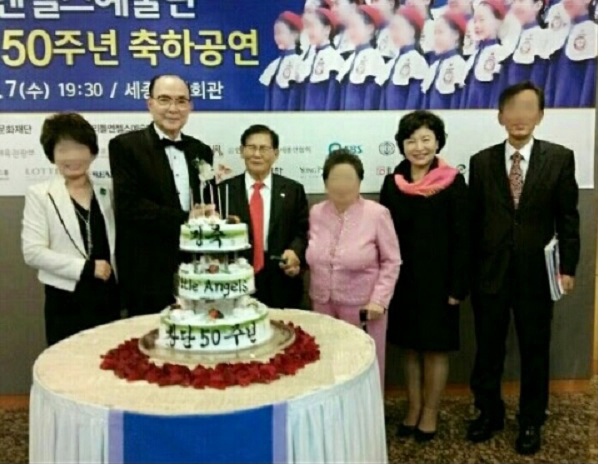
▲ Lee Man-hee and Kim Nam-hee (wearing a pink scarf), photographed with Mr Pak Bo-hi (second from the left) attending a Unification Church Little Angels 50th Anniversary event, probably in 2012. Mrs Pak (wearing a pink suit) is standing next to Mr Lee.
Moon’s theology for his pikareum sex rituals with all the 36 wives
Sun Myung Moon – Restoration through Incest
Newsweek on the many Korean messiahs of the 1970s
The mother of Hak Ja Han was a devotee of Hwang Gook-ju
Chong Deuk-eun – Great Holy Mother
Kim Baek-moon talked about “sexual union with God”
Kim Seong-do and the roots of the Divine Principle
Where Sun Myung Moon got his theology from
Ritual Sex in the Unification Church – Kirsti L. Nevalainen
The Unification Church (FFWPU) and Shamanism
Sun Myung Moon – Emperor, and God
FFWPU Holy Grounds and the Shamanic Guardians of the Five Directions
Shamanism: The Spirit World of Korea
Any understanding of the so-called New Religions of Korea would be difficult without some knowledge of shamanistic influences upon them.

